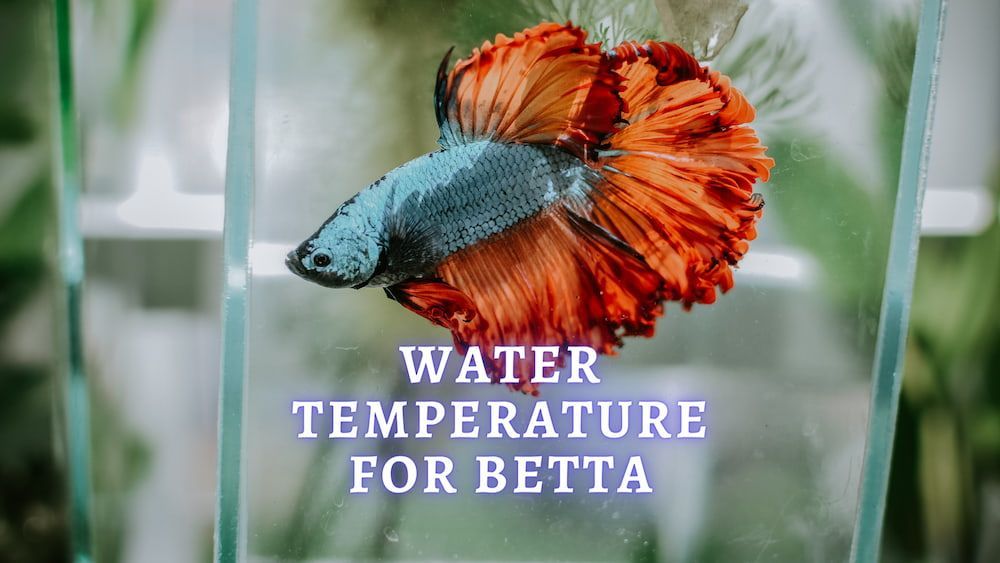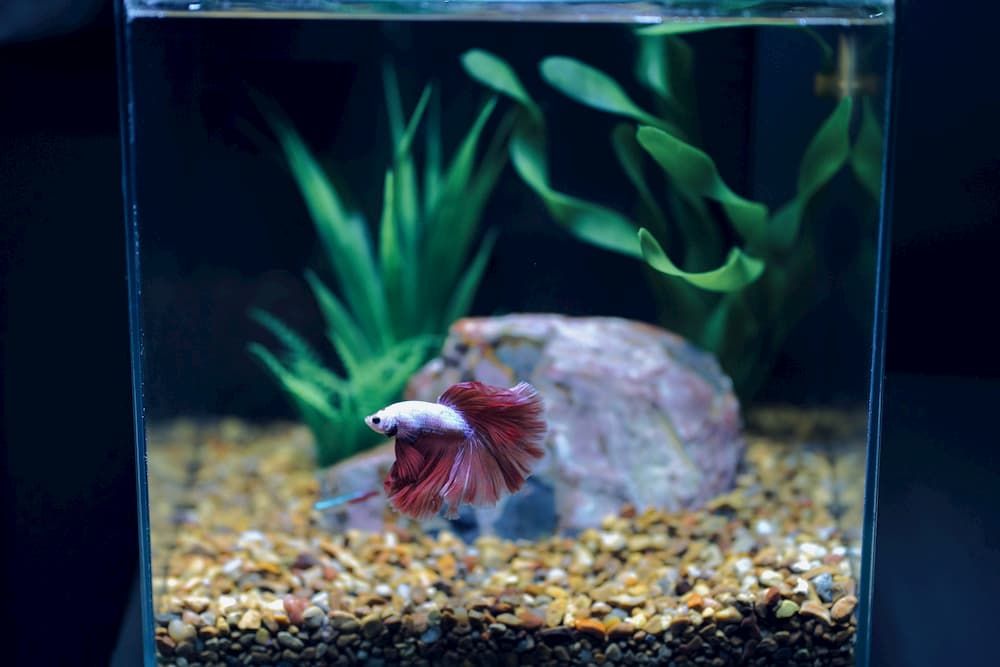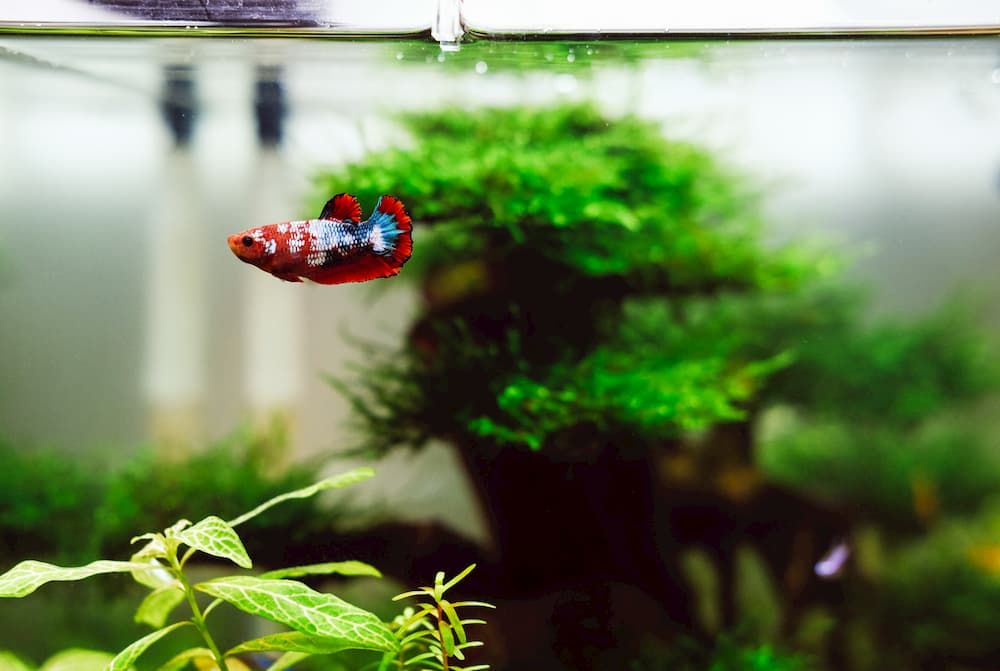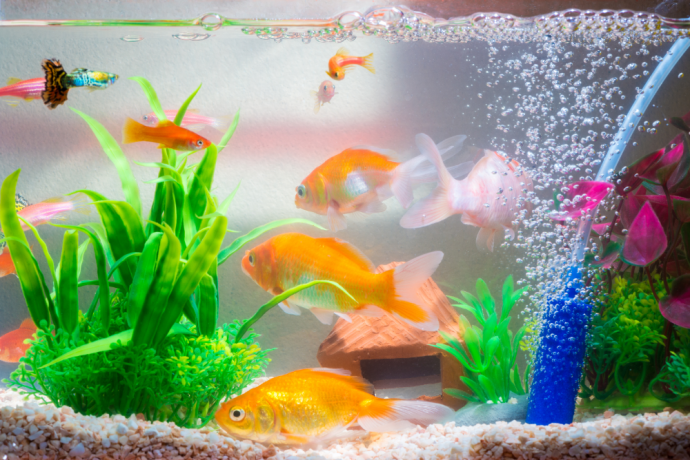Betta Fish Temperatures: Guide To The Perfect Betta Fish Water Temperature
Written by:
Author: Scott Jeffrey
Scott is a professional blogger with 12+ years of experience in writing, and holds an MA in anthropology. He has two cats as housemates. Also, Scott is passionate to research on pet-related topics such as dog training, puppy feeding, and cat health.
View all 63 articlesLearn about our editorial process and veterinary review board.
Viewed: 252
Updated on: 03/07/2023
Keeping your betta fish’s water temperature in their ideal range is essential for their long-term health and well-being. The betta is a great fish for beginners because they don’t take much care and are not as sensitive as other tropical fish. The one area where betta fish require consistent care is their climate in the aquarium.
Pet owners tend to be particular about how they set up and manage their aquariums—and this is especially true regarding the optimal temperature of the tank water. In this article, we’ll dive deeper into understanding why this is so important and what steps you can take to maintain a healthy, comfortable environment for your betta.
When setting up the optimal climate for a betta fish tank, several important factors must be considered. Betta owners usually have to choose between activity levels, color brightness, and longevity of their fish, which can be impacted differently by various temperatures. Depending on the size of an aquarium, warm and cool spots may exist due to water heaters or other items in the tank. In smaller tanks used for bettas, the temperature is likely more consistent throughout. To ensure an appropriate climate and keep your pet fish healthy and comfortable, it’s wise to observe them closely and make adjustments as needed. Here is how to proceed with setting up the tank and getting the water temperature perfect for a betta:
Overall Water Parameters
Maintaining an appropriate and consistent water climate for your betta fish is essential for their long-term health and well-being. The ideal range for most bettas is between 72° and 86°F, with some enthusiasts suggesting a narrower range between 75° and 79°F. However, it’s important to note that each fish may respond differently to various temperatures. So, it’s best to observe how they fare in the conditions you create before settling on one as the ideal.
When adding a new betta fish to a tank, always ensure you acclimate them to the water temperature before releasing them into the tank. Water climate may change considerably when transporting your betta fish from the pet store to your tank. Helping them get used to the environment they will be living in and checking the overall water temperature in the tank before you help the acclimate will be crucial.
When keeping betta fish with other types of fish, check on the care instructions for the other fish species. Betta fish can be good tank neighbors with other species of fish as long as they are not aggressive and prefer warm water. Danios, for example, may need water climate below 74 degrees to thrive and live a healthy life. Research the particular fish species you are introducing to ensure their needs are compatible with your betta’s needs.
READ MORE: Betta Fish Care Guide
Choosing the Right Betta Fish Water Temperature
The right temperature will come down to the preferences of each betta fish. While the suggested range is 72° to 85°F, each betta may require a different temperature to achieve optimal health and behavior. Observing their activity level and coloration in various settings is essential to determine the best climate for your pet.
It can be easier to control climate in smaller betta fish bowl environments. These tropical fish can do well in a small tank as they are used to small pools like rice paddies in their tropical environment.
Having an appropriate monitor and regularly checking on your betta’s temperature will go a long way in ensuring their health and safety. A reliable thermometer that you can use to test the water is essential for achieving accurate results. Look in on your fish at least once a day and make care arrangements if you are away from home for an extended period.
The Best Location for Your Betta Tank
Choosing the right spot for your fish tank is essential for the health and well-being of your aquatic friends. When selecting a location, remember that direct sunlight can speed up algae growth, potentially reaching unhealthy levels. Additionally, make sure you choose a place away from the noise and high traffic, as it can shock fish and cause them to become ill.
The average room climate needs to remain consistent in the room where you hose your betta fish aquarium. Keeping these conditions for your fish tank will help you reach the ideal betta temperature and avoid cold temperatures or overly warm water temperatures.
Furthermore, if you want people to admire your aquarium, pick a spot with good visibility while ensuring electrical sockets are accessible but not directly behind the tank to avoid water splashing onto them. Lastly, ensure certain areas can be easily reached for daily maintenance and care of your fish tank. These tips will help you keep a suitable, consistent climate for your betta fish through a proper location placement for your tank.
Signs Your Water Temperature May Be Too Low With Betta Fish
Betta fish will become lethargic when the water temperature is too low. They will be less likely to eat and become sluggish overall. The lower temperature will also cause their color to fade over time, making them more susceptible to disease. Cold water will change their metabolism as the betta fish water climate should be that of a tropical fish. You may see your betta float to the bottom of the tank if they are experiencing this lethargy, and it can often lead to less fin activity and less likelihood that they will make it to the top of the tank to feed. Sometimes it only takes a difference of 2 degrees in a fast way for a betta to start experiencing the lethargy and lack of appetite that comes with a water temperature that is too low for them.
Signs Your Water Temperature May Be Too High With Betta Fish
When the temperature is too high, your betta may start to get more vibrant in its color patterns. Their gills can sometimes go red, and they generally approach food differently. Under perfect temperatures, a betta gently grabs food from the top of the tank. Under warmer conditions, they often grow more aggressive and snatch at food near the tank’s top.
Bettas in warm tanks will swim around more often and may try to jump out of the water to regulate their temperature. The ideal betta temperature can grow too hot if you have the betta fish aquarium in a room where the tank is in direct sunlight for a few hours each day. If you are seeing a very vibrant and highly active betta fish, there is a good chance the water climate may be just too warm for them.
READ MORE: What to Feed Betta Fish?
What Is Temperature Shock?
As a betta fish is a tropical fish species, they can occasionally experience a condition called temperature shock when exposed to a water condition that is too low for them. When temperatures drop below 72 degrees Fahrenheit, the betta fish is subjected to a strong shock and will have difficulty swimming in their environment. This water is freezing for them and can cause them to shut down and stop swimming. Letheargy is usually the first sign; they can continue to experience damage when exposed to cold water temperatures.
Temperature shock will also present in the form of rapid color loss, the betta fish lying on the bottom of the tank, and even a coma condition when they become too slow. If the betta remains in the coma condition of its lethargy and stops breathing, it could die.
Hot climate shock is also possible with erratic swimming signals and the aforementioned symptoms. A hot shock event could lead to added stress on the fish from the erratic swimming, which can lead to extra energy being expelled or them jumping out of the tank. If you see your fish swimming around the surface rapidly, they could be experiencing this effect which could lead to them expelling too much energy and getting into a state of shock.
Can Temperature Shock Be Reversed in Betta Fish?
Severe cases of climate shock can be complicated to treat, and some cases are fatal. However, catching early enough can reverse temperature shock in betta fish. First and foremost, you should check the water parameters for the temperature to be safe for your fish. As soon as you recognize the behavior that could be a sign of shock, test out the water parameters to see if the climate is off.
If it is off and your fish is not in a critical state, you can take steps to raise or lower the temperature as needed. Be sure to use an aquarium thermometer to adjust the water correctly and not add too much heat or cold at once. A rapid change could be more detrimental to the health of your fish and won’t reverse the effects of climate shock.
Suppose you notice that only one fish in your tank exhibits temperature shock. In that case, you should first move them to a quarantine tank with the correct climate and monitor their medical condition. If the shock continues, it may be best to consider other alternative treatments or they may be sick with another condition unrelated to your tank’s temperature.
How to Increase the Water Temperature in a Betta Fish Tank?
Adjusting the water climate for your betta fish needs to be done gradually. Even if there has been a sharp drop in temperatures, it is best to wait and let the water warm up slowly. The rapid climate changes can cause your betta fish to become stressed out or suffer from shock due to the sudden change. You should increase the temperature by no more than 1-2 degrees Fahrenheit per hour to ensure that your betta can adjust without any issues.
If you need to increase the climate of your betta’s tank, there are a few ways you can do this. You can use an aquarium heater to adjust the temperature in the tank, which is probably the most effective way to do it. If you don’t have access to a heater, you can try cycling in new water that is slightly warmer water than the current one. This is a slower process but still works in increasing the water climate.
With A Heater:
Choose a quality aquarium heater that is suitable for your tank size and has adjustable temperature settings. Place the heater in the tank and ensure it is completely submerged. Plug in the heater and set it to the desired temperature, increasing it gradually over a few hours to not shock your betta fish. A glass-style immersion heater is highly recommended over other heaters as they can work quickly and accurately measure climate. A good quality aquarium heater is an excellent choice if you live in a cooler climate or older home where it could be hard to reach the best betta fish climate in your tank.
Without A Heater:
Using a small thermometer, you can measure the climate of the water in your tank. Begin by replacing 10-20% of the water taken from a slightly warmer source than your current tank temperature (no more than 1-2 degrees Fahrenheit). Test the temperature with a thermometer periodically until it reaches your desired setting, making changes as needed. It is usually better to adjust the temperature via a small heater and to avoid placing your tank in areas that can be heavily affected by sunlight or drops in climate throughout your room.
How to Decrease the Water Temperature in a Betta Tank?
If your betta fish tank’s water climate is becoming too high, you can use a few methods to cool it down. It is essential to avoid drastic changes in temperature as this could shock and stress your betta fish. decrease water temperature over time until you reach the correct water climate for betta fish.
With A Chiller:
A chiller is an aquarium cooling device designed to lower the water climate in your tank. You can purchase a chiller from most pet stores with installation instructions. Ensure you are using an appropriate sized chiller for your tank size, as this will affect its efficiency. Set the chiller to the desired temperature if you notice the water climate is becoming too high. The best chillers will gradually cycle cool water throughout the tank to reduce the temperature safely. The pump circulated water through the unit and a controlled temperature into the tank. Chillers can use extra electricity, so running them only as required when your tank climate runs high is essential. Only use them in your betta’s aquarium when the betta fish water temp becomes too severe.
Without A Chiller:
The most effective way to cool your tank is with a partial water change and by potentially changing the location of your tank to a more shaded area of your home. You can also consider removing artificial lights that could create a warm enviroment in the tank. When changing water, cycle in cooler water (1-2 degrees Fahrenheit lower than the current temperature). Monitor the climate of the water with a thermometer and repeat this process until it reaches your desired setting. This method is essentially the same as using a chiller, with a manual format for adding the water.
Plant Life and Temperature Control With Betta Fish Water Temperature:
Tropical aquarium plants can thrive in environments with a range of 68-84 degrees Fahrenheit. If the water temperature rises or drops above this, it can affect the growth of your plants and can also be dangerous for your betta fish. The nice part about aquatic plants is that if you have betta fish that prefer to live in hot temperatures, there will be cooler areas throughout your tank due to the plant life.
Plant life can also insulate your tank, making it easier to see more stable climate and keep it in the acceptable range for your betta fish and plants. Plants and other environmental changes need to be introduced gradually over time. Still, they can help improve your tank’s environment and make for a healthier place for your betta fish to enjoy. Plants and betta fish can get along symbolically and are a great way to improve the health of your tank.
The Importance of a Stable Water Temperature for Betta Fish Bowl:
Keeping the temperature in a betta fish tank stable and consistent is critical for both fish and their microorganisms. This helps reduce stress levels for the fish, leading to better immunity. Unstable temperatures are known to weaken or even collapse the immune system of siamese fighting fish, so maintaining an environment as close as possible to betta fish’s natural habitat is essential for a healthy life. Additionally, aim for a range between 72° and 85°F; however, observe your pet’s behavior when adjusting to find an ideal climate. Every betta fish is different and has their preferences.
In conclusion, monitoring and adjusting water temperature for betta fish is essential for a healthy and happy life. Knowing the right amount to adjust and having the right tools, such as a heater or chiller, can play an essential role in creating a safe and comfortable environment for your betta. It is also important to note that water temperature should remain consistent and stable, as drastic changes can harm the fish. With careful monitoring and care, you can provide your betta fish with a safe and healthy home!
People also ask
Is 70 Degrees Too Cold For A Betta?
70 Degrees is far too cold for a betta fish. Under these conditions, betta can become lethargic, sick, and stressed. In general, betta fish should be kept at a temperature between 72° and 85°F to maintain optimal health. Add another heater or increase the current setting if your tank is too cold. Additionally, reduce exposure to air conditioning drafts and move the tank away from windows.
Is 82 Degrees Too Hot For A Betta?
82 Degrees is within the safe range for betta fish, but it is definitely near the ideal temperature range. If the water temperature is this high, you should consider cooling it down with a chiller or adding cooler water when performing water changes. Additionally, reduce artificial lights in your tank and move the tank to a shaded area of your home to avoid extreme temperatures. Monitor the fish for signs of distress or lethargy and give them appropriate plant life where they can get shade from artificial lights or the sun. This will help keep the temperature stable and keep your betta fish healthy.
What Temperature Should A Betta Fish Be In?
72° and 85°F is the ideal temperature for a betta fish to be kept in. Adding additional heaters or increasing the current heater’s setting will help if the tank is too cold. If the water is too hot, consider purchasing a chiller or reducing artificial light and moving the tank to a shaded area. Constantly monitor your betta fish for signs of distress and ensure they have access to plant life that can provide shade. Keeping the temperature consistent and stable is essential for a healthy and happy betta fish!
Why Do Betta Fish Need Tropical Temperatures?
Betta fish are originally from southeast Asia and are used to warm tropical climates. Keeping bettas in colder water compromises their immune system and can lead to disease, lethargy, and even death. They are used to tropical water because these are their natural habitats. To ensure health and longevity, betta fish should be kept at a stable range between 72° and 85°F. This mimics the tropical climate they would experience in their native environment. Betta fish are used to surviving in shallow pools that keep their temperatures stable and warm. This is why temperature control is essential for the health and wellbeing of your betta.
 Freshwater Fish 15 Best Fish for Outdoor Ponds: Best and Easiest to Take Care Of
Freshwater Fish 15 Best Fish for Outdoor Ponds: Best and Easiest to Take Care Of - 108
- 0
 Freshwater Fish Snail Eggs in Aquarium and What to Do with Them and How to Remove if Needed
Freshwater Fish Snail Eggs in Aquarium and What to Do with Them and How to Remove if Needed - 92
- 0



























